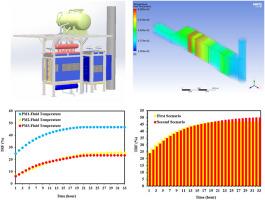Exploring Temperature Reduction Factor (TRF) in a small-scale heat recovery steam generator under shutdown conditions
IF 9.4
1区 工程技术
Q1 ENERGY & FUELS
引用次数: 0
Abstract
Investigating the minimization of HRSG temperature drop during its temporary shutdown is crucial for the purpose of its prompt restart. To achieve this goal, the relative Temperature Reduction Factor (TRF) was introduced and explored at each hour of the shutdown process. Therefore, in this paper, a numerical simulation of the HRSG shutdown process, extending to 118800 s, was performed under two distinct scenarios: the first incorporating a stack damper, and the second excluding it. By regulating the stack damper, the exhaust gas flow, and consequently the heat transfer rate and HRSG cool-down, can be controlled, thereby preventing the occurrence of undesirable thermal stresses. This paper investigates the effect of the stack damper on the critical TRF index, employed as a decision-making and comparative criterion, in order to determine the extent of its contribution to reducing the restart time. The results indicated that the maximum increase in TRF after 33 h of HRSG shutdown, under Scenario 2, is approximately 10 % (55 K) higher than that of Scenario 1. Therefore, under Scenario 2, the restart time increases by approximately 30 min (25 %). Additionally, the results indicate that the use of the Damper Open strategy is permissible if the restart occurs before the 20-h critical time. However, should the system restart process extend to 33 h, the use of the Damper Closed strategy is recommended.

小型热回收蒸汽发生器在停机条件下的温度降低系数(TRF)研究
研究如何在临时停堆期间将HRSG的温度降至最低,对于迅速重启至关重要。为了实现这一目标,在停机过程的每个小时引入并探索了相对温度降低系数(TRF)。因此,本文在两种不同的情况下,对延长至118800s的HRSG关闭过程进行了数值模拟:第一种情况是添加堆栈阻尼器,第二种情况是不添加堆栈阻尼器。通过调节烟囱阻尼器,可以控制废气流量,从而控制传热速率和HRSG冷却,从而防止出现不希望出现的热应力。本文研究了堆阻尼器对临界后机匣指数的影响,并将其作为决策和比较准则,以确定其对减少重新启动时间的贡献程度。结果表明,在HRSG关闭33 h后,在场景2下,TRF的最大增幅比场景1高出约10% (55 K)。因此,在场景2下,重启时间增加了大约30分钟(25%)。此外,结果表明,如果重新启动发生在20小时的临界时间之前,则允许使用阻尼器打开策略。但是,如果系统重启过程延长到33小时,则建议使用阻尼器关闭策略。
本文章由计算机程序翻译,如有差异,请以英文原文为准。
求助全文
约1分钟内获得全文
求助全文
来源期刊

Energy
工程技术-能源与燃料
CiteScore
15.30
自引率
14.40%
发文量
0
审稿时长
14.2 weeks
期刊介绍:
Energy is a multidisciplinary, international journal that publishes research and analysis in the field of energy engineering. Our aim is to become a leading peer-reviewed platform and a trusted source of information for energy-related topics.
The journal covers a range of areas including mechanical engineering, thermal sciences, and energy analysis. We are particularly interested in research on energy modelling, prediction, integrated energy systems, planning, and management.
Additionally, we welcome papers on energy conservation, efficiency, biomass and bioenergy, renewable energy, electricity supply and demand, energy storage, buildings, and economic and policy issues. These topics should align with our broader multidisciplinary focus.
 求助内容:
求助内容: 应助结果提醒方式:
应助结果提醒方式:


